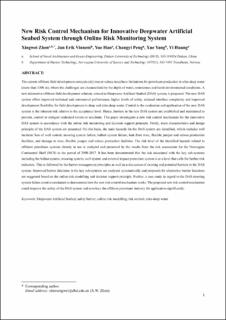| dc.description.abstract | The current offshore field development concepts (dry tree or subsea tree) have limitations for petroleum production in ultra-deep water (more than 1500 m), where the challenges are characterized by the depth of water, remoteness and harsh environmental conditions. A new alternative offshore field development solution, termed as Deepwater Artificial Seabed (DAS) system, is proposed. The new DAS system offers improved technical and commercial performance, higher levels of safety, reduced interface complexity and improved development flexibility for field development in deep and ultra-deep water. Central to the evaluation and application of the new DAS system is the inherent risk relative to the acceptance level. Hence, barriers in the new DAS system are established and maintained to prevent, control or mitigate undesired events or accidents. This paper investigates a new risk control mechanism for the innovative DAS system in accordance with the online risk monitoring and decision support principle. Firstly, main characteristics and design principle of the DAS system are presented. On this basis, the main hazards for the DAS system are identified, which includes well incident/ loss of well control, mooring system failure, ballast system failure, leak from riser, flexible jumper and subsea production facilities, and damage to riser, flexible jumper and subsea production facilities. The risk level of the identified hazards related to offshore petroleum systems already in use is analyzed and presented by the results from the risk assessment for the Norwegian Continental Shelf (NCS) in the period of 2008–2017. It has been demonstrated that the risk associated with the key sub-systems including the ballast system, mooring system, well system and external impact protection system is at a level that calls for further risk reduction. This is followed by the barrier management principles as well as a discussion of existing and potential barriers in the DAS system. Improved barrier functions in the key sub-systems are analyzed systematically and proposals for alternative barrier functions are suggested based on the online risk modeling and decision support principle. Further, a case study in regard to the DAS mooring system failure event is conducted to demonstrate how the new risk control mechanism works. The proposed new risk control mechanism could improve the safety of the DAS system and convince the offshore petroleum industry for application significantly. | en_US |
